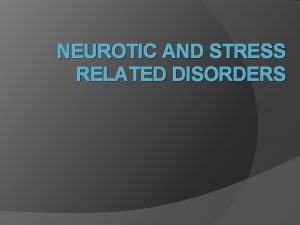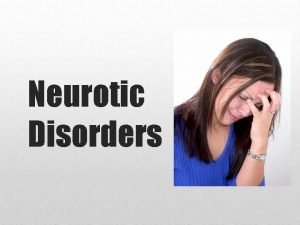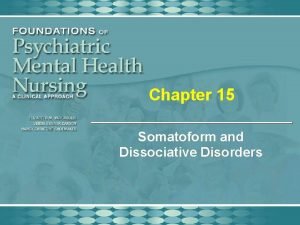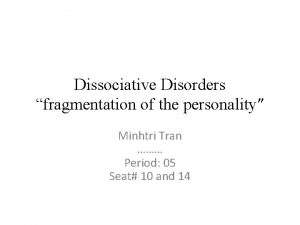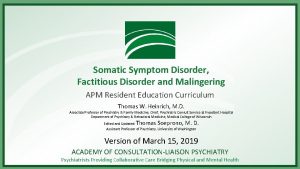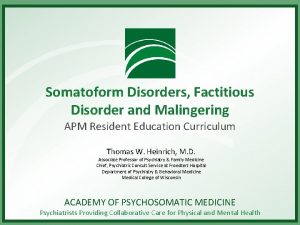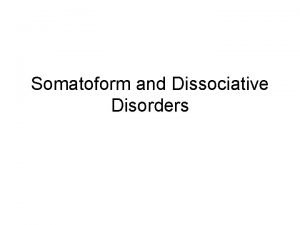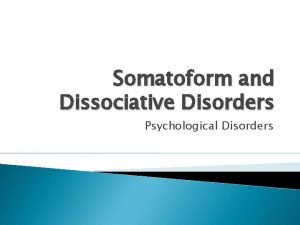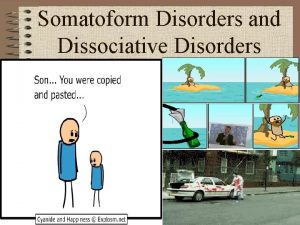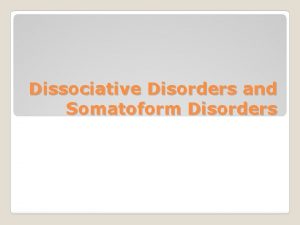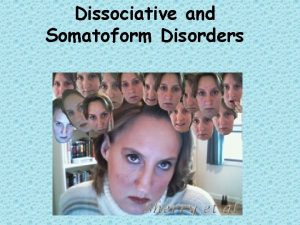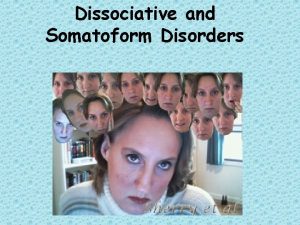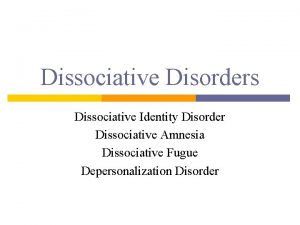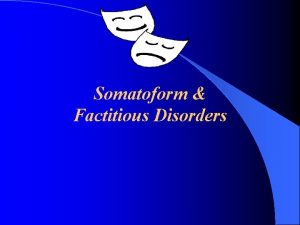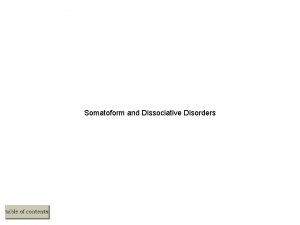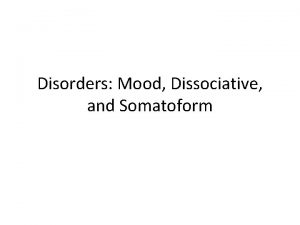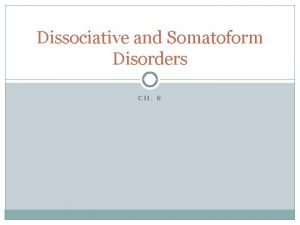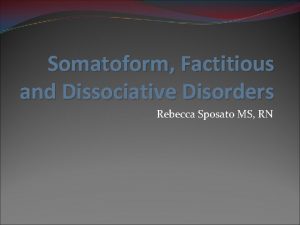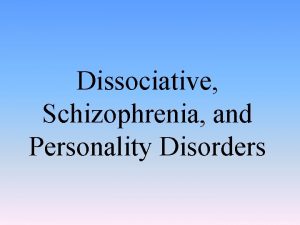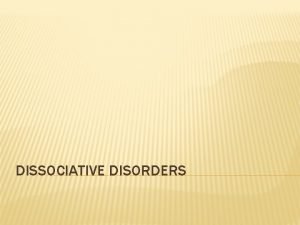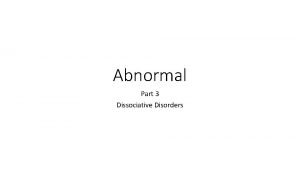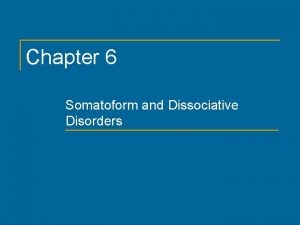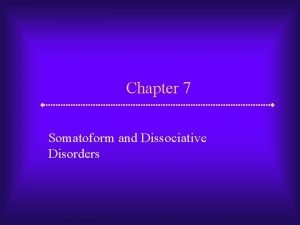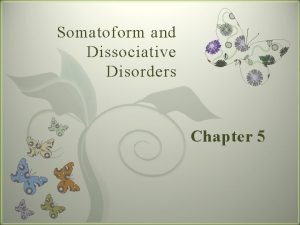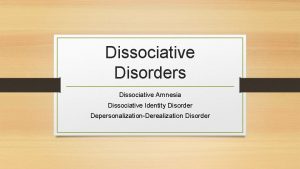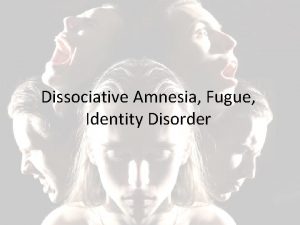Somatoform Factitious and Dissociative Disorders CHAPTER 22 Elsevier























- Slides: 23

Somatoform, Factitious, and Dissociative Disorders CHAPTER 22 Elsevier items and derived items © 2010, 2006 by Saunders, an imprint of Elsevier Inc. 1

Somatoform Disorders • Physical symptoms suggest a physical disorder for which there is no demonstrable base • Strong presumption that symptoms linked to psychobiological factors Elsevier items and derived items © 2010, 2006 by Saunders, an imprint of Elsevier Inc. 2

Somatoform Disorders • Somatization disorder • Undifferentiated somatoform disorder • Conversion disorder • Pain disorder • Hypochondriasis • Body dysmorphic disorder • Somatoform disorder not otherwise specified Elsevier items and derived items © 2010, 2006 by Saunders, an imprint of Elsevier Inc. 3

Somatization Disorder • Most common somatoform disorder • Significant functional impairment • Symptoms – Pain, GI symptoms, sexual symptoms, and pseudoneurological symptoms • Course of illness chronic and relapsing • Suicide threats and gestures common Elsevier items and derived items © 2010, 2006 by Saunders, an imprint of Elsevier Inc. 4

Hypochondriasis • Misinterpretation of physical sensations • Overconcern for health and preoccupied with symptoms • Extreme worry and fear • Course of illness chronic and relapsing Elsevier items and derived items © 2010, 2006 by Saunders, an imprint of Elsevier Inc. 5

Pain Disorder • Diagnostic testing rules out organic cause • Discomfort leads to impairment • Associated with higher rates of depression • Usual sites of pain are head, face, lower back, pelvis Elsevier items and derived items © 2010, 2006 by Saunders, an imprint of Elsevier Inc. 6

Body Dysmorphic Disorder • Preoccupation with an imagined defective body part • Obsessional thinking and compulsive behavior • Fear of rejection by others, perfectionism, and conviction of being disfigured lead to emotions of disgust, shame and depression Elsevier items and derived items © 2010, 2006 by Saunders, an imprint of Elsevier Inc. 7

Conversion Disorder • Presence of deficits in voluntary motor or sensory functions • Common symptoms – paralysis, blindness, movement and gait disorders, numbness, paresthesias, loss of vision or hearing, or episodes resembling epilepsy • “La belle indifférence” versus distress • Comorbid conditions – depression, anxiety, other somatoform disorders, personality disorders Elsevier items and derived items © 2010, 2006 by Saunders, an imprint of Elsevier Inc. 8

Etiology • Biological factors • Genetics • Biochemical imbalances that cause pain to be experienced more intensely • Psychosocial factors – Psychoanalytic theory – Behavioral theory – Cognitive theory Elsevier items and derived items © 2010, 2006 by Saunders, an imprint of Elsevier Inc. 9

Somatoform Disorders: Assessment • Symptoms and unmet needs • Voluntary control of symptoms • Secondary gains • Cognitive style • Ability to communicate feelings and emotional needs • Dependence on medication Elsevier items and derived items © 2010, 2006 by Saunders, an imprint of Elsevier Inc. 10

Somatoform Disorders: Implementation • Basic level interventions – Promotion of self-care activities – Health teaching and health promotion – Case management – Pharmacological interventions • Advanced practice interventions – Psychotherapy Elsevier items and derived items © 2010, 2006 by Saunders, an imprint of Elsevier Inc. 11

Factitious Disorders • Consciously pretend to be ill to get emotional needs met and attain status of “patient” • Three subtypes – Predominately physical symptoms – Predominantly psychological symptoms – Combinations of physical and psychological symptoms Elsevier items and derived items © 2010, 2006 by Saunders, an imprint of Elsevier Inc. 12

Examples of Factitious Disorders • Factitious disorder with physical symptoms • Munchausen syndrome • Factitious disorder with psychological symptoms • Factitious disorder by proxy Elsevier items and derived items © 2010, 2006 by Saunders, an imprint of Elsevier Inc. 13

Malingering =Symptoms are consciously produced or feigned =Have various motivations, including financial gain, relief of work duties, or obtaining illicit drugs =Obvious secondary gain(s) Elsevier items and derived items © 2010, 2006 by Saunders, an imprint of Elsevier Inc. 14

Dissociative Disorders • Disturbances in the normally wellintegrated continuum of consciousness, memory, identity, and perception • Unconscious defense mechanism • Protects individual against overwhelming anxiety Elsevier items and derived items © 2010, 2006 by Saunders, an imprint of Elsevier Inc. 15

Depersonalization Disorder • Alteration in perception of self • Reality testing remains intact • Disturbing experiences of – Feeling a sense of deadness of the body – Seeing oneself from a distance – Perceiving limbs to be larger or smaller than normal Elsevier items and derived items © 2010, 2006 by Saunders, an imprint of Elsevier Inc. 16

Dissociative Amnesia • Inability to recall important personal information • Often of traumatic or stressful nature – Generalized amnesia – Localized amnesia – Selective amnesia Elsevier items and derived items © 2010, 2006 by Saunders, an imprint of Elsevier Inc. 17

Dissociative Fugue • Sudden unexpected travel away from the customary locale • Inability to recall one’s identity and some or all of the past • During fugue state tend to live simple, quiet lives • When former identity remembered, become amnestic for time spent in fugue state Elsevier items and derived items © 2010, 2006 by Saunders, an imprint of Elsevier Inc. 18

Dissociative Identity Disorder • Presence of two or more distinct personality states • Primary personality (host) usually not aware of alters • Alternate personality (alters) or subpersonalities take control of behavior • Alters often aware of each other • Each alter thinks and behaves as a separate individual Elsevier items and derived items © 2010, 2006 by Saunders, an imprint of Elsevier Inc. 19

Dissociative Disorders: Assessment • Identity and memory • History • Moods • Impact on patient and family • Suicide risk Elsevier items and derived items © 2010, 2006 by Saunders, an imprint of Elsevier Inc. 20

Dissociative Disorders: Implementation • Basic level interventions – Milieu therapy – Health teaching and health promotion – Pharmacological interventions • Advanced practice interventions – Cognitive-behavioral therapy – Psychodynamic psychotherapy Elsevier items and derived items © 2010, 2006 by Saunders, an imprint of Elsevier Inc. 21

Personal Challenges to Professional Practice = Focus on your feelings and be cognizant of your reactions. = Monitor your own feelings of defensiveness, impatience, frustration, or anger toward the client. = Practice increased self-awareness. = Don’t judge, criticize, or make assumptions. = Pain is determined and defined by the client. = Pain of psychic origin is as hurtful as pain of biologic origin. Elsevier items and derived items © 2010, 2006 by Saunders, an imprint of Elsevier Inc. 22

Personal Challenges to Professional Practice =Be alert for signs of secondary gain. =Avoid reinforcing negative behaviors. =Address client with a matter-of-fact approach. =Reinforce adaptive vs. maladaptive behaviors. Elsevier items and derived items © 2010, 2006 by Saunders, an imprint of Elsevier Inc. 23
 Neurotic, stress-related and somatoform disorders
Neurotic, stress-related and somatoform disorders Neurotic personality disorder
Neurotic personality disorder Somatic symptom disorder
Somatic symptom disorder Somatoform disorders
Somatoform disorders Somatoform disorder
Somatoform disorder Dissociative disorders
Dissociative disorders Types of dissociative disorders
Types of dissociative disorders Derealization quotes
Derealization quotes Somatization disorder dsm 5
Somatization disorder dsm 5 Somatization disorder dsm 5
Somatization disorder dsm 5 Adventitious ideas examples
Adventitious ideas examples Vindicate mnemonic
Vindicate mnemonic Somatization disorder
Somatization disorder Gangguan somatoform
Gangguan somatoform Hyperventilation
Hyperventilation Epidemiologi gangguan somatoform
Epidemiologi gangguan somatoform Associative and dissociative social process
Associative and dissociative social process Chapter 8 skin disorders and diseases
Chapter 8 skin disorders and diseases Chapter 6 musculoskeletal system
Chapter 6 musculoskeletal system Chapter 46 digestive and endocrine disorders
Chapter 46 digestive and endocrine disorders Chapter 29 endocrine and metabolic disorders
Chapter 29 endocrine and metabolic disorders Chapter 21 mental health diseases and disorders
Chapter 21 mental health diseases and disorders Chapter 18 eating and feeding disorders
Chapter 18 eating and feeding disorders Chapter 17 reproductive system diseases and disorders
Chapter 17 reproductive system diseases and disorders
